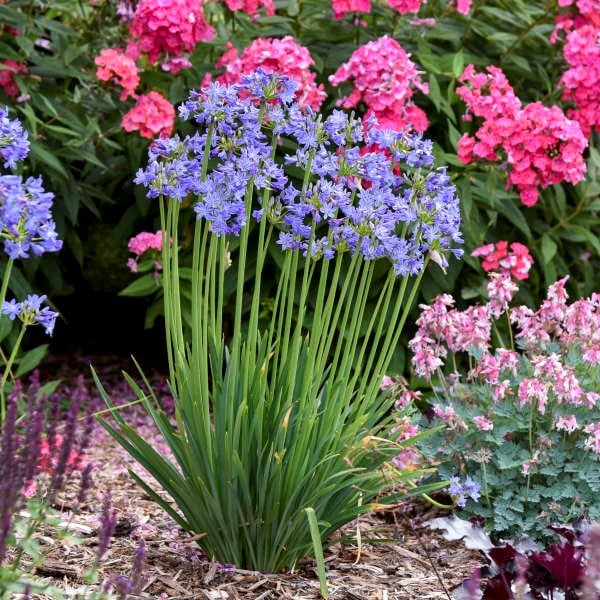Agapanthus Friend Plant Kingdoms: Perfect Pairings for Your Garden
Agapanthus Friend Plant Kingdoms: Perfect Pairings for Your Garden
Blog Article
Letting Loose the Secret to Effective Agapanthus Growing: Tips and Techniques for a Flourishing Yard
In the world of horticulture, cultivating agapanthus efficiently requires a calculated strategy that includes different facets of plant treatment. By comprehending the subtleties of agapanthus cultivation, one can develop an environment where these plants flourish and flower perfectly.
Planting Agapanthus: Finest Practices
When planting Agapanthus, appropriate dirt prep work is important for making certain successful development and development of these lovely flowers. Agapanthus, typically called Lily of the Nile or African lily, prospers in well-draining dirt with a somewhat acidic to neutral pH level - Agapanthus. Before growing, it is critical to amend hefty clay soils with raw material such as garden compost or peat moss to improve drainage and offer crucial nutrients for the plants
To plant Agapanthus, pick a location that receives full sunlight to partial shade, as this will advertise healthy growth and plentiful flowering. Dig a hole two times the size of the plant's origin round and put the Agapanthus at the exact same deepness it was formerly growing. Carefully backfill the hole with dirt, weighing down strongly to get rid of any air pockets around the roots.
Water the freshly grown Agapanthus thoroughly and continue to maintain the dirt equally wet, particularly during the plant's active growing period. Agapanthus. Using a well balanced fertilizer once a month can further support the plant's growth and blooming. By complying with these finest methods for growing Agapanthus, you can create a stunning display screen of these fascinating blossoms in your garden
Ideal Soil Conditions for Agapanthus
For optimum growth and blooming success of Agapanthus plants, making certain the soil problems are optimal is crucial. Agapanthus favors soil that is abundant in nutrients, so integrating a well balanced plant food during the expanding period can promote healthy and balanced development and dynamic flowers.

Watering and Feeding Tips
To guarantee healthy development and lively blooms, appropriate watering and feeding methods are important for successful Agapanthus farming. Agapanthus plants profit from normal watering, particularly throughout the growing season.
When it pertains to fertilizing Agapanthus, a well balanced plant food with equivalent components nitrogen, phosphorus, and potassium can be used in the springtime to advertise healthy and balanced development and flowering. Slow-release fertilizers are perfect for providing nutrients slowly over an extended duration. Prevent over-fertilizing, as this can lead to too much foliage growth at the expenditure of flowers.
In addition, integrating organic issue like compost right into the soil can enhance nutrient degrees and enhance dirt structure, assisting in the total health and wellness of the Agapanthus plants. By following these watering and feeding ideas, gardeners can guarantee their Agapanthus plants flourish and produce spectacular displays of read what he said blossoms.
Pruning and Deadheading Methods
Proper trimming and deadheading techniques play a critical role in keeping the health and aesthetics of Agapanthus plants, enhancing the vital techniques of watering and fertilizing for successful growing. Pruning Agapanthus involves eliminating spent flower heads, dead or yellowing leaves, and total shaping of the plant to promote better growth. Deadheading, the process of eliminating discolored blossoms, not just enhances the plant's appearance however additionally urges further flowering.
When deadheading Agapanthus, it is suggested to trim off the blossom stem at the base using sharp, clean shears. This procedure reroutes the plant's power from seed manufacturing back right into root and foliage development, promoting a much healthier and extra durable plant. Regular deadheading can extend the flowering duration of Agapanthus and protect against self-seeding, which can bring about overcrowding.
In terms of pruning, Agapanthus typically benefits from a light trim after blooming to clean up the plant and urge fresh development. Cutting back the spent blossom stems and getting rid of any type of damaged or dead vegetation aids maintain the plant's vigor and overall appearance. However, it is vital to prevent reducing right into the crown of the plant, as this can weaken its health.

Protecting Agapanthus From Vermins and Diseases
Applying effective pest and condition administration techniques is essential to safeguarding the wellness and vigor of Agapanthus plants in cultivation. Agapanthus are generally durable plants, however they can still come down with different insects and diseases if not effectively taken care of. One usual insect that affects Agapanthus is the Agapanthus borer, a caterpillar that tunnels right into the plant, causing damages to the leaves and blossoms. To prevent infestations, normal assessment of the plants is important. If borers are found, they can be manually eliminated, or insecticidal soap can be used as a control step.
In enhancement to bugs, Agapanthus are vulnerable to illness such as root rot and fungal fallen leave places. By remaining attentive and attending to insect and disease issues quickly, garden enthusiasts can help their Agapanthus flourish and grow.

Verdict
Finally, successful farming of agapanthus requires appropriate blog here planting techniques, suitable soil conditions, adequate watering and fertilizing, normal pruning and deadheading, and defense from insects and conditions. By following these ideas and tricks, garden enthusiasts can make sure a growing yard filled with attractive agapanthus flowers. Agapanthus. Keep in mind to preserve regular care and interest to information to advertise the health and wellness and long life of these stunning plants
When planting Agapanthus, correct dirt preparation is necessary for making certain effective development and development of these stunning blossoms.Water the freshly planted Agapanthus completely and continue to maintain the dirt equally moist, specifically throughout the plant's active expanding season.For optimal growth and flowering success of Agapanthus plants, making sure the dirt conditions are excellent is critical. When transplanting or planting Agapanthus, ensure the soil is well-prepared to supply the essential foundation for the plants to establish themselves efficiently. One usual pest that impacts Agapanthus is the Home Page Agapanthus borer, a caterpillar that tunnels right into the plant, causing damages to the flowers and fallen leaves.
Report this page